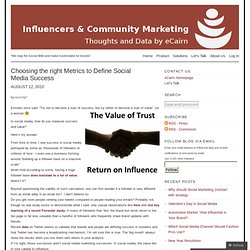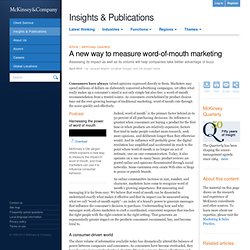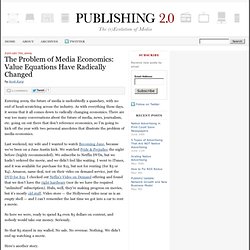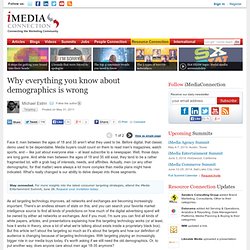

Choosing the right Metrics to Define Social Media Success. Einstein once said: “Try not to become a man of success, but try rather to become a man of value”.

(or a woman ;-) In social media, how do you measure success and value? Here’s my answer: From time to time, I see success in social media portrayed by some as ‘thousands of followers or millions of fans’. I even see a business forming around “building up a follower base on a massive scale”. Beyond questioning the validity of such calculation, one can first wonder if a follower is very different from an email addy in an email list? So I have a problem with defining/buzzing success with such metrics. When Einstein wrote his quote, he was talking about the intention supporting our actions and self. Conversation Impact Model (full) Depends on market maturity. Consumers have always valued opinions expressed directly to them.

Marketers may spend millions of dollars on elaborately conceived advertising campaigns, yet often what really makes up a consumer’s mind is not only simple but also free: a word-of-mouth recommendation from a trusted source. As consumers overwhelmed by product choices tune out the ever-growing barrage of traditional marketing, word of mouth cuts through the noise quickly and effectively. Podcast. Financial & non financial assets. Lies, damned lies and statistics.
Marketing math: whole system. Model Conversation Impact - Social Media Measurement for Marketers. On s’attend quoi des média sociaux NOW? We need f***ing ROI. Vous vous souvenez sans doute de la série des présentations « What a F**k is Social Media ».

Aujourd’hui que Facebook viens de toucher le cap de 500 mil d’ utilisateurs, ne pouvait pas manquer une MAJ pour faire le point sur le « Social Media readiness » du marché. Pour être honnête je suis pas sur que des donnes quantitatives sont suffisantes, pour avoir une vison réel dans la quelle un business ou une pratique sociale se développe; c’est à mon avis la façon dans la quelle la population réagit à l’innovation qui fais la différence.
Quel usage réel nous faisons des outils? Vous trouvez donc ici des donnes mises à jour, mais aussi des considérations qui sont moins philosophiques que auparavant, démontrent que les média sociaux sont de plus en plus partie de notre quotidien. Secrets of Social Media Revealed 50 Years Ago - David Aaker - The Conversation. By David Aaker | 8:00 AM June 17, 2011 Almost 50 years ago Ernest Dichter, the father of motivation research, did a large study of word of mouth persuasion that revealed secrets of how to use social media to build brands and businesses.

The study was reported in a 1966 article in HBR. A major Dichter finding, very relevant today, was the identification of four motivations for a person to communicate about brands. The first (about 33% of the cases) is because of product-involvement. The experience is so novel and pleasurable that it must be shared.
SM = preemptive ROI. The Problem of Media Economics: Value Equations Have Radically Changed. Entering 2009, the future of media is undoubtedly a quandary, with no end of head-scratching across the industry.

As with everything these days, it seems that it all comes down to radically changing economics. There are way too many conversations about the future of media, news, journalism, etc. going on out there that don’t reference economics, so I’m going to kick off the year with two personal anecdotes that illustrate the problem of media economics.
Last weekend, my wife and I wanted to watch Becoming Jane, because we’ve been on a Jane Austin kick. We watched Pride & Prejudice the night before (highly recommended). We subscribe to Netflix DVDs, but we hadn’t ordered the movie, and we didn’t feel like waiting. So here we were, ready to spend $4 even $5 dollars on content, and nobody would take our money. So that $5 stayed in my walled. Here’s another story. Over the holiday, we helped some relatives post a listing for basement apartment on Craisglist. Why everything you know about demographics is wrong. Face it; men between the ages of 18 and 35 aren't what they used to be.

Before digital, that classic demo used to be dependable. Media buyers could count on them to read men's magazines, watch sports, and -- like just about everyone else -- at least subscribe to a newspaper. Well, those days are long gone. And while men between the ages of 18 and 35 still exist, they tend to be a rather fragmented lot, with a grab bag of interests, needs, and affinities. Actually, men (or any other demographic, for that matter) were always a lot more complex than media plans might have indicated. Stay connected. As ad targeting technology improves, ad networks and exchanges are becoming increasingly important. How important is the traditional demo? "I wouldn't say traditional demographics are becoming less relevant; rather I would say their role is being diminished as a direct result of the increased role technology is playing," said Jeff Silverstein, managing partner at CL&S.
Wrong indicators because of the TV habits. You've Got the Wrong Measures! The prevailing business philosophy around social media are consumed with measuring everything with the aim of determining effectiveness. The marketplace is exploding with tools to provide data insights, knowledge and wisdom about what are and aren’t effective social media strategies. The obsession with measuring all things social is indicative of thinking inside rather than out. Inside thinking focuses on justification of time, energy and efforts all aimed at creating results. Outside thinking focuses on learning market needs and intents.